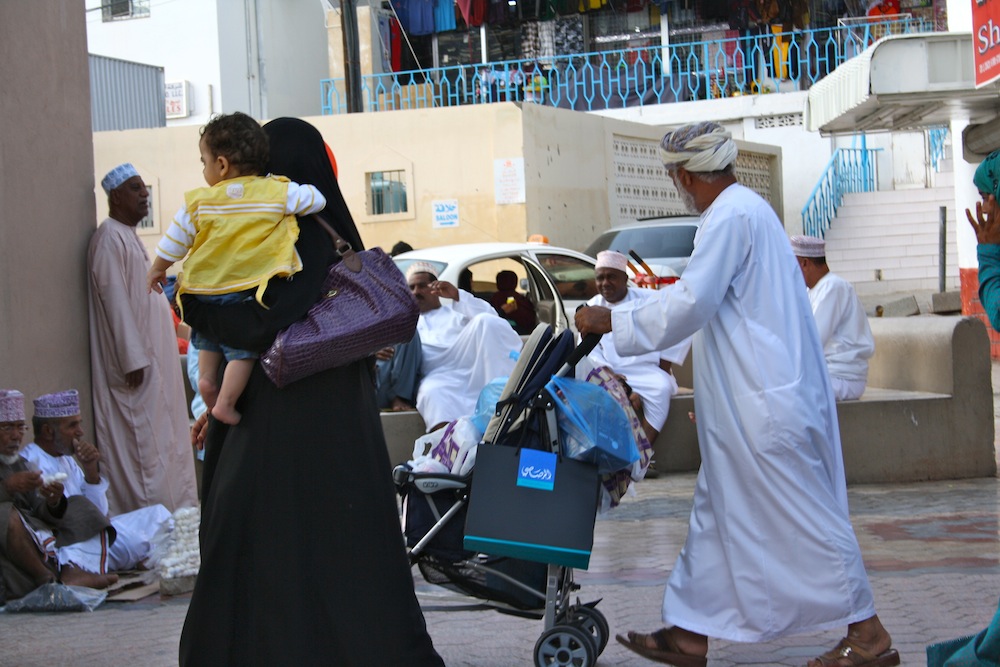
The Sultan modernized the country but values traditions: The dishdascha is obligatory in government jobs
by Stop FGM Middle East
30.11.2013, Muscat. The activist Habiba Al Hinai has asked women in shopping malls and clinics about female genital mutilation. 78 percent reported to be circumcised – more than even the most FGM-critical Omani bloggers estimated (“Linoleum Surfer” assumed 20 percent victims). What is even more surprising about Al-Hinai’s ad-hoc-study: The women interviewed come from all regions in Oman: Muscat, the Batina, the Dakhiliya, the Sharqia. Only 2 came from Dhofar. So far, most people believed that FGM was mainly practiced in the Southern province of Dhofar.
A team of Wadi’s and Hivos’ Stop FGM Middle East campaign is currently in Oman, talking with local actors about these findings, their own assesment and ideas how to campaign against female genital mutilation.
The account of the blogger “Omani Princess” in Muscat supports Al Hinai’s finding. She tells us that it is practiced by her in-laws. They come from the mountains near Muscat, the Dakhiliya. “It is done with a hot needle”, she has heard. Her husband knows that in some cases a nail clipper is used.
At the Omani Women’s Association the women are surprised. “No, it’s not a problem here in Muscat and not in the mountains,” insists Nashia Al Kharusi, the president of the local Muscat branch. She has long heard of the practice in Dhofar and thinks the Ministry of Health should do something to stop it. “Maybe some do it in the North because they are influenced by the Emirates?” she ponders.
That FGM is practiced widely in the Emirates is well known in Oman. Also the Omani Princess tells us about it. She is well connected with other women in the region and since she believes that FGM is a crime she has talked with them about it. She can tell us: It is practiced in Bahrain, in Kuwait and also in Jordan.
But the “Omani Princess” doesn’t know how to overcome the social taboo surrounding the topic. “Unthinkable to write about it in an Arabic newspaper, only the English ones can publish articles on it.” This is also the opinion of a journalist from the Muscat Daily we meet.
Habiba Al Hinai explains to us why only the official Women’s Association can initiate a campaign. “There are no independent NGOs, you won’t get a license and you won’t be allowed to work.” She must know. As one of the main protagonists of the small Omani spring she has tried to found several groups with others, among them the Omani Human Rights’ organization.
Yet, the women at the Women Association don’t seem too confident. Al Kharusi has been trying to get an appointment at the Ministry of Health to talk about FGM. “They must do something, because in Oman things have to be official.” She is certain that FGM could be eliminated within few years “because if something comes from the government, people follow.” This may well be true. Sultan Qaboos is a popular monarch for he integrated all ethnic and religious groups, modernized the country and improved the status of women to such an extend that the Thomas Reuters Foundation recently rated Oman as the second best Arab country for women.
Even the activist Habiba says: “If it wasn’t for the Sultan we would still live imprisoned. These people (the religious) would lock us in the house not allowing us to work or even go out.”

[…] from: http://stopfgmmiddleeast.wordpress.com/2013/11/30/field-trip-to-oman-fgm-is-acknowledged-but-everyone… […]